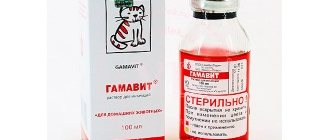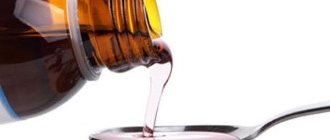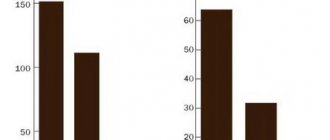Release form, packaging and composition of the drug Clinical-pharmacological group Pharmaco-therapeutic group Pharmacological action Indications for use Method of administration and doses Side effects Contraindications for use Use in children Special instructions Drug interactions
Registration Certificate Holder:
KRASFARMA, PJSC (Russia)
ATX Code:
B05AA05
Active substance:
dextran
Dosage form:
Dextran 40
| The drug is available with a prescription | Dextran 40 | R-r d/inf. 10%: bottle. 200 ml or 400 ml reg. No.: LSR-007071/08 dated 09/04/08 - Indefinitely |
Indications for use
Solutions of high molecular weight dextran: severe posthemorrhagic hypovolemia, hypovolemic shock due to trauma, blood loss during childbirth, as a result of ectopic pregnancy, etc. Hypovolemia caused by loss of plasma (burns, compartment syndrome). Preoperative and postoperative embolism prevention.
Solutions of low molecular weight dextran: microcirculation disorders, traumatic shock, burn shock, compartment syndrome. Septic shock. Plasma volume replacement during blood loss in pediatrics. For filling artificial blood circulation machines (in certain proportions with blood).
Dextran with a molecular weight of 1000: prevention of severe allergic reactions to intravenous administration of dextran solutions.
Contraindications
- bleeding disorders (hemophilia, thrombocytopenia);
- CRF (chronic renal failure) with anuria;
- chronic heart failure in the stage of decompensation (high probability of developing pulmonary edema);
- individual hypersensitivity to the components of the drug.
The use of Dextran 40 for medicinal electrophoresis is contraindicated in cases of copious mucopurulent discharge and maceration of the skin of the eyelids.
During pregnancy and breastfeeding, the drug is used with caution.
Directions for use and doses
The method of administration and dosage regimen of a particular drug depend on its release form and other factors. The optimal dosage regimen is determined by the doctor. The compliance of the dosage form of a particular drug with the indications for use and dosage regimen should be strictly observed.
Solutions of high molecular weight dextran are administered intravenously at a rate of 60-80 drops/min in quantities of up to 2-2.5 liters (with significant blood loss - with additional blood injection).
Solutions of low molecular weight dextran, when used as a blood substitute, are usually administered in the same doses. In other cases, the daily dose should not exceed 20 ml/kg. The rate of IV infusion is determined by the indications and severity of the patient's condition.
Dextran with a molecular weight of 1000 is administered intravenously in a bolus to adults at a dose of 3 g (20 ml), to children - at a dose of 45 mg/kg (0.3 ml/kg) - 1-2 minutes before the intravenous infusion of dextran solution. The interval between the administration of dextran with a molecular weight of 1000 and the infusion of dextran solution should not exceed 15 minutes. If more than 15 minutes have passed, then dextran with a molecular weight of 1000 should be reintroduced. It can be administered before each infusion of dextran solution, especially if more than 48 hours have passed since the previous infusion.
Dextran 40
Individual, determined by the patient’s condition, blood pressure, heart rate, hematocrit.
Method of administration: intravenous stream, stream-drip and drip. The dose and rate of administration of the drug should be selected individually, in accordance with the indications and condition of the patient.
When using the drug, it is necessary to conduct a biotest: after slowly introducing the first 5 drops of the drug, stop the transfusion for 3 minutes, then inject another 30 drops and stop the infusion again for 3 minutes. If there is no reaction, the administration of the drug continues. The results of the bioassay must be recorded in the medical history.
1. In case of disruption of capillary blood flow (various forms of shock), it is administered intravenously by drip or jet-drip, in a dose of 0.5 to 1.5 l, until hemodynamic parameters are stabilized at a life-supporting level. If necessary, the amount of the drug can be increased to 2 liters.
In children with various forms of shock, it is administered at a rate of 5-10 ml/kg, the dose can be increased if necessary to 15 ml/kg. It is not recommended to reduce the hematocrit value below 25%.
2. For cardiovascular and plastic surgeries, it is administered intravenously, immediately before surgery, for 30-60 minutes to adults and children at a dose of 10 ml/kg, during surgery for adults - 500 ml, for children - 15 ml/kg. After surgery, the drug is administered intravenously (over 60 minutes) for 5-6 days at the following rate: adults - 10 ml/kg once, children under 2-3 years old - 10 ml/kg once a day, children under 8 years old - 7-10 ml/kg 1-2 times a day, children under 13 years old - 5-7 ml/kg 1-2 times a day. For children over 14 years of age, the doses are the same as for adults.
3. During operations under artificial circulation, the drug is added to the blood at the rate of 10-20 ml/kg of the patient’s body weight to fill the oxygenator pump.
The concentration of dextran in the perfusion solution should not exceed 3%. In the postoperative period, the doses of the drug are the same as for cases of capillary blood flow disturbance.
4. For the purpose of detoxification, it is administered intravenously in a single dose of 500 to 1250 ml (in children 5-10 ml/kg) for 60-90 minutes. If necessary, you can pour another 500 ml of the drug on the first day (in children, the administration of the drug on the first day can be repeated in the same doses). In the following days, the drug is administered dropwise, for adults - at a daily dose of 500 ml, for children - at a rate of 5-10 ml/kg. Together, it is advisable to administer crystalloid solutions (Ringer's and Ringer's acetate, etc.) in such quantities as to normalize the water-electrolyte balance (especially important when treating dehydrated patients and after surgical operations); the drug, as a rule, causes an increase in diuresis (a decrease in diuresis indicates to dehydrate the patient).
5. In ophthalmological practice, it is used by electrophoresis, which is carried out in a generally accepted way. The drug consumption per procedure is 10 ml. The procedure is carried out once a day, administered from both the positive and negative poles. Current density - up to 1.5 mA/sq.cm. The duration of the procedure is 15-20 minutes. The course of treatment consists of 5-10 procedures.
special instructions
Due to possible allergic reactions, the first 10-20 ml of infusion solution is recommended to be administered slowly, while monitoring the patient's condition. Given the possibility of developing arterial hypertension, it should be borne in mind that appropriate means for intensive care may be required. Dextran with a molecular weight of 1000 cannot be diluted or mixed with dextran solutions for infusion. Dextran with a molecular weight of 1000 can be administered intravenously through the Y-branch or rubber tubing of the infusion set, provided that the injection does not significantly dilute the drug.
Release form and composition
Dextran 40 is produced in the form of a solution for infusion 10%: colorless or yellowish transparent liquid (100, 200, 250, 400, 500 ml in polyethylene bottles; for hospitals, 1–96 bottles in a cardboard box; 200 or 400 ml in bottles glass, 1 bottle in a cardboard box; for hospitals 20, 24 or 28 bottles of 250 ml or 15 bottles of 450 ml in a cardboard box).
Composition per 1 liter of Dextran 40 solution:
- active substance: dextran (average molecular weight 35,000–45,000) – 100 g;
- auxiliary ingredients: sodium chloride, water for injection.
METHOD FOR PRODUCING LOW MOLECULAR DEXTRANE Russian patent 1995 according to IPC C08B37/02
The invention relates to the field of polymer chemistry, in particular to the chemistry of polysaccharides.
Polysaccharides are widely used in the food and pharmaceutical industries. These polysaccharides include dextran, which is an α-1,6-glucan obtained by microbiological synthesis from sucrose. The product of microbiological synthesis, native dextran, is a high-molecular glucose polymer with a molecular weight MW (25-30) ˙106, has a wide molecular weight distribution (MWD) and polydispersity MW/MN reaches values of 100 or more.
Aqueous solutions of native dextran are highly viscous liquids, the intrinsic viscosity is 1.4-2.3 dl/g. Therefore, the use of native dextran without preliminary destruction in pharmacological preparations, in particular in blood plasma substitutes, is not possible.
In the production of blood plasma substitutes, low molecular weight dextran (LMD) with an MW of 30,000-70,000 is used. To do this, native dextran is subjected to some type of destruction: acid or alkaline hydrolysis, ultrasonic or thermal destruction. Low molecular weight dextran used in the production of blood plasma substitutes must meet a number of requirements: mol.m. 30000-70000; narrow molecular weight distribution to exclude the content of undesirable low and high molecular weight fractions; the characteristic viscosity of the aqueous solution should not exceed 0.28-0.30.
There is a known method for producing low molecular weight dextran by acid hydrolysis of native dextran [1]. According to a known method, the destruction of native dextran is carried out by splitting the molecules with hydrochloric or sulfuric acid when heating the solution, after which, to isolate the target product having the necessary MWD, low molecular weight dextran is subjected to fractionation by alcohol precipitation to remove unwanted high and low molecular weight polysaccharide fractions. In this case, about 30% of dextran is lost, i.e. the yield of the final product is approximately 70%. It has been established that the polydispersity of the target product, for example, in the production of the plasma substitute polyglucin, has a value of MW/MN 2.3.
With this method, modification of dextran does not occur, and new functional groups are not formed in the glycosidic units of low molecular weight dextran.
The closest technical solution is a method for producing low-molecular dextran by irradiating dry native dextran with high-energy electrons [2]. According to this method, a solution of native dextran is pre-dried, and then the powder in the presence of alkali is irradiated with high-energy electrons.
The lack of complete homogeneity of dextran and alkali leads to unevenness of the destruction process, and this leads to the fact that the final product, low molecular weight dextran, has a very wide molecular weight distribution, the polydispersity MW/MN exceeds 10. As a result, dextran irradiated with accelerated electrons is subjected to alcohol fractionation. In this case, about 30-40% of dextran is lost, i.e. the yield of a product suitable for obtaining a blood plasma substitute is 60-70%. There is no information on the modification of low molecular weight dextran. The product obtained by this method is characterized by an intense yellow-brown color, which is reduced by additional processing of a solution of low molecular weight dextran on sorbents when heated. According to this method, to obtain low molecular weight dextran with mol.m. 50,000 use a radiation dose of 800 kGy.
The invention solves the following problems: reducing the integral radiation dose required to achieve mol.m. dextran 30000-70000, 3.5-4.5 times (in terms of dry dextran); obtaining low molecular weight dextran with a molecular weight distribution that meets the requirements for blood plasma substitutes, without additional fractionation, i.e. having a polydispersity MW/MN of no more than 2.0; increasing the yield of the final product up to 100% improving the quality of the final product due to the modification of dextran by including new functional groups (CO, COOH) with a relative content of modified glycosidic units of 4.2-8.4% in the molecules of low molecular weight dextran during radiation-initiated destruction improving the quality of the final product by eliminating its coloration; ensuring the sterility of the final product of an aqueous solution of low molecular weight dextran, which is an important aspect in the production of blood plasma substitutes.
The objectives are solved in that in the method of producing destructured dextran by exposing high molecular weight dextran to ionizing radiation, an aqueous solution containing 5-11 g/dl of native high molecular weight dextran and 0.02-0.22 wt. hydrogen peroxide, having a pH of 9-12, and exposure is carried out with γ-rays with a dose of 7.6-28.2 kGy at 10-50°C.
The boundary values of the content of hydrogen peroxide in the irradiated solutions were chosen such that the process of radiation destruction could be realized with a minimum dose of gamma irradiation, and during irradiation all hydrogen peroxide completely reacted and was absent from the final product. The lower limit of H2O2 concentration was chosen to be 0.05 wt. since at lower concentrations of H2O2 the effect of dose reduction is comparable to the experimental error in determining molecular masses and radiation dose. The upper limit of H2O2 concentration was chosen to be 0.22 wt. since an additional increase in the concentration of hydrogen peroxide in irradiated aqueous solutions of dextran does not lead to a further reduction in the radiation dose.
Solutions of low molecular weight dextran (LMD) obtained by the proposed method do not require subsequent purification and can be directly used as the basis for a blood plasma substitute.
The temperature range of the process (10-50°C) was chosen so that, on the one hand, the viscosity of the native dextran solution was not too high, and on the other hand, a sharp thermal decomposition of hydrogen peroxide did not occur.
The pH range of 9-12 is chosen so that after radiolysis the solutions have a physiologically acceptable pH of 4.0-7.0, which blood plasma substitutes should have.
The NMDs given in the examples have molecular weights in the range MW 30,000-70,000, and concentrations in the range of 5-11 g/dl, which is due to the requirements for blood plasma substitutes of hemodynamic and rheological action (polyglucin, macrodex, reopolyglucin, rheomacrodex).
When exposed to γ-radiation on aqueous solutions of native dextran, the indirect effect of radiation prevails, i.e. Radiolysis of water occurs with the release of particles, the most reactive of which are OH radical, hydrated electron, and H radical. The hydrated electron practically does not interact with dextran, but with a high probability it reacts with H2O2, leading to a sharp increase in the yield of OH radicals, thereby increasing the rate of dextran destruction.
Example 1. 1000 l of a solution of native high molecular weight dextran with a concentration of 6 g/l at 25°C is placed in the apparatus, the pH is adjusted to 10.8-11.2 by adding 3 l of 2 N NaOH, and 3 l of 34 wt. hydrogen peroxide to a H2O2 concentration of 0.12 wt. the solution is mixed and sent for irradiation in a coil-type γ-installation. The dose rate of the γ-irradiator is 3.0 Gy/s. The solution is irradiated with an integral dose of 9.5 kGy.
After irradiation, a colorless solution of low molecular weight dextran with a concentration of 5.98 g/dl and mol.m is obtained. 68200, relative viscosity 2.78, intrinsic viscosity 0.181 dl/g, pH 4.6, no residual hydrogen peroxide in the solution. Polydispersity, which characterizes the MWD of low molecular weight dextran, is 1.92, which allows the use of a solution of low molecular weight dextran without additional fractionation, i.e. the yield of the final product is 100%. Low molecular weight dextran is modified, its molecules have the following chemical structure where k 426, l 6, m 12.
The relative content of glycosidic units with carbonyl C 0 groups is 1.36% and of glycosidic units with carboxyl COOH groups is 2.72%, i.e. the total content of modified glycosidic units is 4.08% EXAMPLES 2-16 are performed similarly to example 1 with other parameters. The results are presented in the table.
All solutions of low molecular weight dextran obtained in examples 1-16 were sterile and had no color.
Drug interactions
- aprotinin: increases the likelihood of developing unwanted side effects;
- aminocaproic acid, hydralazine, dexamethasone, streptokinase, suxamethonium iodide and suxamethonium chloride: incompatible with dextran;
- heparin sodium, apixaban, streptokinase, parnaparin sodium, nadroparin calcium: increase the risk of bleeding; It is recommended to adjust the dosage of parnaparin sodium to prevent a decrease in the level of blood clotting by more than 1.5 times.
Terms and conditions of storage
Keep away from children!
Transportation and storage conditions:
- polyethylene bottles: at a temperature of 10–25 ° C, in a dry place; Freezing is allowed during transportation;
- glass bottles: at temperatures up to 25 °C in a dry, dark place; Freezing is allowed provided the bottle remains sealed; non-wetting of the inner surface of the bottle walls is not a reason to refuse to use the solution.
Shelf life – 2 years.
Side effects
Due to the use of Dextran 40 solution, the following side effects may develop: chills, fever, fever, nausea, hypersensitivity reactions (skin rashes; anaphylatoxic reactions - oliguria, low blood pressure, collapse). The development of acute renal failure and bleeding is also possible.
In case of excessive administration of dextran solution (overdose), it is necessary to carefully assess the patient’s condition and carry out appropriate symptomatic therapy.



